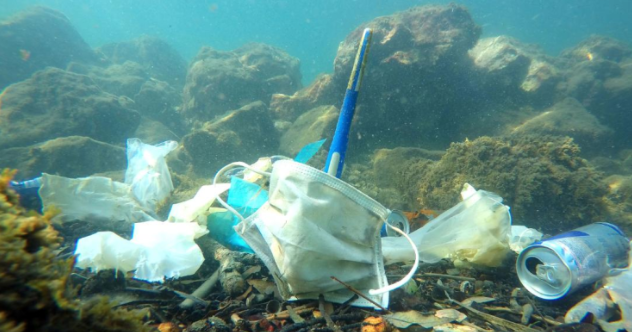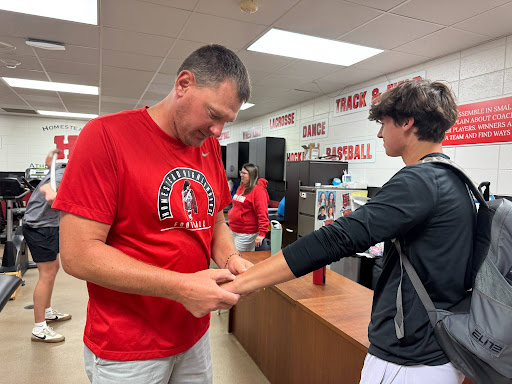Pandemic behaviors affect environment
Despite the positive changes the pandemic has brought, severe plastic waste has been evident across worldwide waterways and habitats resulting from COVID-19 materials.
The groundbreaking virus, COVID-19, has caused countless global setbacks: worldwide death and sickness, education uncertainty, economic deficit, millions of lost jobs, travel delay and so much more.
However, out of the endless obstacles of the wide-spread pandemic, environmental issues have actually seen major benefits since the initial lockdown in 2020.
The environment’s well-being has been carefully monitored for centuries, but research is both showing signs of improvement across the globe, but also signs of decline.
Back in March, 2020, the world shut down to prevent the spread of the extremely contagious virus, COVID-19. Schools, restaurants, businesses and so much more reworked into at-home styles instead of staying in public within contact of others in the community. As people developed new hobbies, got into shape, explored more and problem-solved into new ways of communicating, the environment flourished in some areas like air and water quality and worsened in others including the waste left behind.
A considerable slowdown of social and economic activities has brought a considerable improvement in air quality around the world. Vehicles are the largest contributor to the dangerous emissions in the airspace, so with a mitigation of drivers travelling to work, a substantial decrease in air pollution is evident.
Katrina Liberman, senior AP research student, has examined some changes in the world around us as she finishes up her project on the viability of solar energy. Through her six-month research study, she noticed the COVID-19 impacts on crucial greenhouse gases. “Human activities that cause pollution, emissions, and other environmental harm were reduced,” and as a result, “reduced transportation has decreased greenhouse gas emissions,” Liberman said.
Aviation transportation is also one of the largest factors into emissions released into the environment, and the pandemic has taken an extensive toll on it.
Tanjena Rume and S.M. Didar-Ul Islam, both part of the Development of Environmental Sciences at Jahangirnagar University, shared their studies on the environment changes subsequent to the global lockdown.
As an example, one can look at China’s alteration in air transportation and the influence it has had on the environment. “China reduces almost 50–90% capacity of departing and 70% domestic flights due to the pandemic, compared to January 20, 2020, which ultimately deducted nearly 17% of national CO2 emissions,” Rume, et al said.
On top of air quality recovery, the universal waterways have seen huge breakthroughs since the start of the pandemic. The rivers, lakes, and oceans’ pollution is going down drastically with fewer transportation emissions released into the atmosphere. Fewer toxic minerals are reaching the water surface, boosting water life’s health as an ecosystem.
Tanjena Rume vocalized her conclusions after a second experiment done with S.M. Didar-Ul Isla. During the lockdown period, “the major industrial sources of pollution have shrunk or completely stopped, which helped to reduce the pollution load,” bettering the well-being of the waterways. “This improvement of water quality at Haridwar and Rishikesh was ascribed to the sudden drop of the number of visitors and 500% reduction of sewage and industrial effluents,” Rume, et al said.
Despite the various beneficial impacts that COVID-19 has provided, few unpleasant outcomes have been evident as well. With more at-home meals and supplies needed for daily activities transitioning away from the public, much more plastic waste has been secreted into the waterways, habitats and parks.
Dawn Pfaff, science teacher, has been observing the changes made around us since the beginning of the pandemic.
After being asked about the visible impacts, Pfaff noticed one negative aspect: an “increase in use of single use or pre packaged items. This increases our amount of landfilled trash and supports a throwaway society,” which has supplemented the “global climate change,” Pfaff said.
Along the same lines of waste growth, Chloe Monteiro, junior, vice president of the Environmental Club, agreed with the root destruction from these pre-packaged and single use items. More paper and plastic needed is not just innocently created, but instead destroying the habitat of millions of species. Supplies in demand are clearly necessary, but they are also exceedingly increasing “deforestation in the Amazon Rainforest,” Monteiro summarized.
Consequently, citizens globally have been taking significant measures in trying to sustain a healthy environment before it is irreversible. From large to small changes made, a group effort can substantially better the world around us, making alterations nobody can predict until they are taken into effect.
Wide-reaching revisions are being made through federal, state and city governments daily. The Center for Climate and Energy Solutions reports on the government’s attempts in preventing decay. At the national level, the executive branch has created various regulations protecting separate areas of the broad natural challenges. First, the “The Clean Air Act” was created to “work with states to reduce greenhouse gas emissions, including carbon dioxide and methane,” “Federal” said.
Secondly, conditions have been set to The Department of Transportation to “require the Department of Energy to partner with the private sector to research, develop, and deploy clean energy technologies, and to set energy efficiency standards for appliances and equipment,” “Federal” said. And the list of improvements continues with many acts and rules already in place. On a much smaller scale, individuals around the community are modifying their everyday life in a hope to enhance the atmosphere we live in.
Liberman shared the steps she takes for the strengthening of the natural world, and the pandemic’s impacts on them. “I personally try to make sustainable personal choices (being vegan, using minimal plastic/being as zero waste as possible, etc.) and have been for many years. The pandemic almost made it easier to be more sustainable because I drive less and shop locally for produce. I don’t think I can say the same for everyone, because I am incredibly privileged that I am able to choose my habits and be more sustainable,” Liberman said.
Conclusively, as more and more people make simple alterations to their life, the environment can and will get better for the generations to come, similar to some of the betterments COVID-19 has temporarily provided.
Using multi-use materials such as reusable water bottles, bags and containers can make one of the most effective improvements to the environment and isn’t overly difficult to undertake. Additionally, recycling every item that is recyclable is crucial in order for wasteful products to be reprocessed and lessen the amount of waste deposited in landfills, waterways, habitats, and so forth.
Lastly, dangerous air contributions are resulting from cars, planes, trains and other transportation vehicles travelling across the globe secreting emissions into the atmosphere. Minimizing the number of cars driving to and from activities every person endures is a critical difference people can readily make.
With no improvements being made revolving this immensely vital issue facing our world, it will only get worse, and before we know it, the habitat of millions of species, let alone people, will be destroyed. The world’s population must do everything in its power to end this before it’s too late.
“The effects of lockdowns have solidified my view that human activities and the things we are dependent on for everyday life (precovid) are dangerous for our planet,” Liberman said.

Lauren Van Vooren, a junior at Homestead High School is committed to academic and athletic pursuits. She has enjoyed participating in the Homestead’s...






